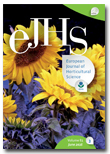


ISSN 1611-4426 print and 1611-4434 online | © ISHS 2016 | European Journal of Horticultural Science | Original article
Test of a PAR sensor-based, dynamic regulation of LED lighting in greenhouse cultivation of Helianthus annuus
T. Schwend, M. Beck, D. Prucker, S. Peisl and H. Mempel
Institut für Gartenbau, University of Applied Sciences Weihenstephan-Triesdorf, Freising, Germany
|
SUMMARY
The intensity, and consequently the energy consumption, of light emitting diodes (LEDs) can be regu-lated. Therefore, LEDs can be implemented in new, dynamic energy saving strategies. Recently it has been shown that a program, which adjusts the intensity of a LED to the current solar PAR, reduced its energy consumption by 20%. The effect of a dynamic LED lighting on ornamental crops has not been tested. In this study we compared the growth of the model plant Helianthus annuus under a dynamic versus a static, control LED lighting. The data of this study show that the dynamic LED consumed 21% less energy than a control LED. However, there was no difference in crop quality or time to anthesis. Keywords energy conservation, light intensity, light quality, photosynthetically active radiation |
Significance of this study
What is already known on this subject?
|
|
|
|
E-mail: heike.mempel@hswt.de
References
Albright, L.D., Both, A.-J., and Chui, A.J. (2000). Controlling greenhouse light to a consistent daily integral. T. ASABE 43, 421–431. https://doi.org/10.13031/2013.2721.
Bergstrand, K.J., and Schüssler, H. (2012). Growth and photosynthesis of ornamental plants cultivated under different light sources. Acta Hortic. 956, 141–148. https://doi.org/10.17660/ActaHortic.2012.956.13.
Buwalda, F., Eveleens, B., and Wertwijn, R. (2000). Ornamental crops tolerate large temperature fluctuations: A potential for more efficient greenhouse heating strategies. Acta Hortic. 515, 141–150. https://doi.org/10.17660/ActaHortic.2000.515.17.
Faust, J.E., Holcombe, V., Rajapakse, N.C., and Layne, D.R. (2005). The effect of daily light integral on bedding plant growth and flowering. HortScience 40, 645–649.
Heuvelink, E., and Challa, H. (1989). Dynamic optimization of artificial lighting in greenhouses. Acta Hortic. 260, 401–412. https://doi.org/10.17660/ActaHortic.1989.260.26.
Marcelis, L.F.M., Broekhuijsen, A.G.M., Meinen, E., Nijs, E.M.F.M., and Raaphorst, M.G.M. (2006). Quantification of the growth response to light quantity of greenhouse grown crops. Acta Hortic. 711, 97–104. https://doi.org/10.17660/ActaHortic.2006.711.9.
McCree, K.J. (1972). The action spectrum, absorptance and quantum yield of photosynthesis in crop plants. Agric. Meteorology 9, 191–216. https://doi.org/10.1016/0002-1571(71)90022-7.
Mortensen, L.M. (1994). Effects of day/night temperature variations on growth, morphogenesis and flowering of Kalanchoe blossfeldiana v. Poelln. at different CO2 concentrations, daylengths and photon flux densities. Sci. Hortic. 59, 233–241. https://doi.org/10.1016/0304-4238(94)90016-7.
Oh, W., Cheon, I.H., and Kim, K.S. (2009). Photosynthetic daily light integral influences flowering time and crop characteristics of Cyclamen persicum. HortScience 44, 341–344.
Pinho, P., Hytönen, T., Rantanen, M., Elomaa, P., and Halonen, L. (2013). Dynamic control of supplementary lighting intensity in a greenhouse environment. Light Res. Technol. 45, 295–304. https://doi.org/10.1177/1477153512444064.
Pocock, T. (2015). Light-emitting diodes and the modulation of speciality crops: light sensing and signalling networks in plants. HortScience 50, 1281–1284.
Pramuk, L.A., and Runkle, E.S. (2005). Photosynthetic daily light integral during the seedling stage influences subsequently growth and flowering of Celosia, Impatiens, Salvia, Tagetes and Viola. HortScience 40, 1336–1339.
Schmidt, U. (1998). Low-cost system for on-line measurement of plant transpiration and photosynthesis in greenhouse production. Acta Hortic. 421, 249–257. https://doi.org/10.17660/ActaHortic.1998.421.26.
Schneiter, A.A., and Miller, J.F. (1981). Description of sunflower growth stages. Crop Sci. 21, 901–903. https://doi.org/10.2135/cropsci1981.0011183X002100060024x.
Schwend, T., Prucker, D., and Mempel, H. (2015). Red light promotes compact growth of sunflowers. Eur. J. Hortic. Sci. 80, 56–61. https://doi.org/10.17660/eJHS.2015/80.2.2.
Smith, H., and Whitelam, G. (1997). The shade avoidance syndrome: multiple responses mediated by multiple phytochromes. Plant Cell Environ. 20, 840–844. https://doi.org/10.1046/j.1365-3040.1997.d01-104.x.
Received: 26 February 2016 | Revised: 15 April 2016 | Accepted: 23 May 2016 | Published: 20 June 2016 | Available online: 20 June 2016